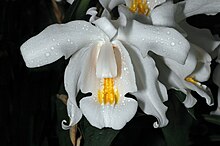Coelogyne
| Coelogyne | |
|---|---|
 |
|
| Coelogyne cristata | |
| Scientific classification | |
| Kingdom: | Plantae |
| (unranked): | Angiosperms |
| (unranked): | Monocots |
| Order: | Asparagales |
| Family: | Orchidaceae |
| Subfamily: | Epidendroideae |
| Tribe: | Arethuseae |
| Subtribe: | Coelogyninae |
| Genus: |
Coelogyne Lindl. 1821 |
| Species | |
|
See text. |
|
See text.
Coelogyne is a genus of over 200 sympodial epiphytes from the family Orchidaceae, distributed across India, China, Indonesia and the Fiji islands, with the main centers in Borneo, Sumatra and the Himalayas. They can be found from tropical lowland forests to montane rainforests. A few species grow as terrestrials or even as lithophytes in open, humid habitats. The genera Bolborchis Lindl., Hologyne Pfitzer and Ptychogyne Pfitzer are generally included here. The genus is abbreviated Coel in trade journals.
The wide distribution of this genus has resulted in a wide variety of temperature variation from species to species, some requiring cool to cold conditions to grow and bloom reliably, while others need decidedly warmer temperatures to achieve the same.
The scientific name is derived from the Greek words koilos (hollow) and gyne (woman), referring to the concave stigma.
This genus lacks the saccate base of the labellum, a typical characteristic which is present in the other genera in the subtribe Coelogyninae. The free lip has high lateral lobes along the basal part of the labellum (hypochile) and smooth, toothed or warty keels.
The pseudobulbs of one internode vary in size. They may be closely or widely spaced through sympodial growth along the rhizome.
Inflorescences often show a small to very large number of showy, medium-sized to large flowers. They may arise either from the apex of the newly completed pseudobulb at the end of the growing season (as in Coelogyne fimbriata), or may precede the new growth in early spring (as in Coelogyne cristata). The typical colour range of this genus is white, through tawny brown to green, and occasionally peachy tones. All species have four pollinia.
...
Wikipedia
